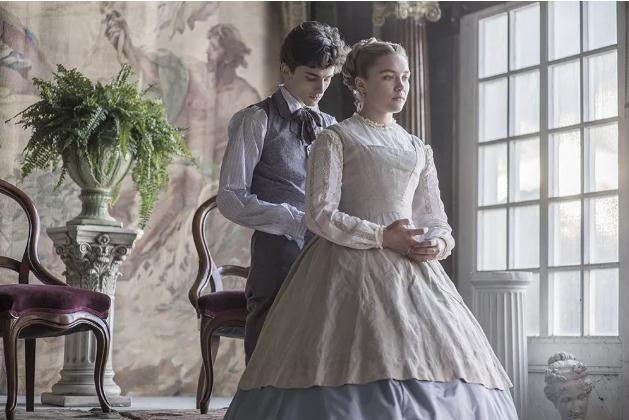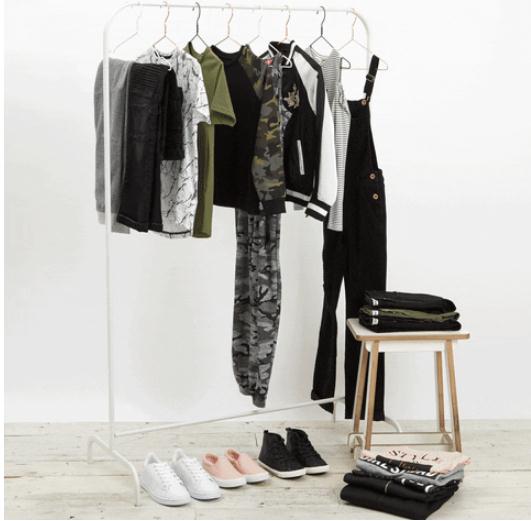女生穿男装早就不是什么新鲜事了。
有可能是“随便找了件男票的衣服套着”。
但单身汪们逛街的时候跑到同品牌男装区选购,通常是给自己买。
问她们为什么。回答普遍是:“好看啊”、“实用啊”、“相同的价位,尺码却大几圈,作oversize(大码)穿多好啊!”
男女装之间存在哪些不那么显而易见的差异,让人做出不循常规的消费决策呢?
下面这些不同点,穿过异性衣服的人才会知道。

口袋
作家Lucy Rycroft-Smith曾试着一个月只穿男装,她发现的第一件事就是口袋的差异。
We need to talk about pockets. The clothes I'm wearing now have bountiful, multifaceted, capacious pockets. I have nine of them today. I counted them. On a typical day of wearing womenswear, I have NONE.
我得说说口袋。我现在穿的男装,口袋巨多,每一面都有,而且都超大超能装。我今天穿的这件就有9个口袋,我数过了!想想我穿女装的日子,一个口袋也没有。
Another realization like a wet herring to the face: The "handbag vs pockets" thing is huge confidence-underminer, another terribly effective, if inadvertent way, to hold women down.
我还常听说一个逻辑谬误:“女人有包,要啥口袋”。简直又是无意间把女人当作要区别对待的弱势群体。

I remember being crouched over my handbag, furiously ferreting for a business card while my male colleague coolly produced one from his manly chest-cavity.
我记得以前带手提包的时候,不得不蹲在那疯狂找名片,而我的男同事已经潇洒地从胸前口袋里掏出来了。
布丁网的研究者们搜集了美国最畅销的20个牛仔裤品牌,测量了它们的男女裤装的口袋大小。
The average sizes for both women and men. The measurements confirmed what every woman already knows to be true: women’s pockets are ridiculous.
男裤与女裤前口袋的平均大小对比。该测量数据证实了每个女人都知道的事:女裤口袋是来搞笑的。
On average, the pockets in women's jeans are 48% shorter and 6.5% narrower than men’s pockets.
平均而言,女裤口袋比男裤口袋短48%,窄6.5%。

Beyond the obvious measurement differences, we wanted to see just how functional all these pockets were. After all, a pocket is only as good as what you can fit in it.
除开这些表面的测量数据,我们还想知道这些口袋的功能表现如何。毕竟,要看口袋有多好,得看它有多能装。
Only 40 percent of women’s front pockets can completely fit one of the three leading smartphone brands. Less than half of women’s front pockets can fit a wallet specifically designed to fit in front pockets. And you can’t even cram an average woman’s hand beyond the knuckles into the majority of women’s front pockets.
女裤的口袋中,只有40%能放得下市面上常见的智能手机。不到一半的女裤口袋能装得下小钱包,这里说的还是那种为裤子前口袋特意定制的小钱包。这还没完,大部分的女裤前口袋,你甚至连手都放不进去。

扣子
On shirts, the buttons are on the left for the ladies and on the right for the gents.
女衬衫的扣子在左侧,而男衬衫的扣子在右侧。
When buttons were invented in the 13th century, they were, like most new technology, very expensive. Wealthy women back then did not dress themselves — their lady’s maid did. Since most people were right-handed, this made it easier for someone standing across from you to button your dress.
扣子是13世纪发明的,和许多新技术一样,那时的扣子非常昂贵。家境殷实的女人不需要自己更衣,都是女仆帮忙。鉴于大多数人都是右利手,把扣子放在左侧方便站在对面的人帮你穿衣。
As for men’s shirts, there are a few competing theories as to why buttons are on the right side. But as a general rule, many elements of men’s fashion can be traced back to the military. Once again, the right-handed assumption played a role since access to a weapon practically trumped everything - a firearm tucked inside a shirt would be easier to reach from the dominant side.
男衬衫扣子为什么在右侧,各种解释很多。但总的来讲,很多男性衣着的设计历史上都受到行军打仗的影响。这次,又是“右利手假说”可以解释 —— 扣子设计在右侧的话,右手从扣子缝里伸进去拿别在衬衫里的枪是最方便的。

舒适性
专栏作家Lucy Rycroft-Smith曾在石英网撰文吐槽“为什么男装都设计得那么舒服?”
For most of my life, I’ve worn clothing that leaves a mark. Bra straps nip at my shoulders; the backs of my shoes dig into my skin. Pantyhose leaves red rings around my stomach at the end of the day—glaring, and just as affecting, as felt-tip marks from a plastic surgeon.
我人生大部分时间穿的东西都是会在我身上留下印记的那种。文胸肩带会勒肩膀,鞋子后跟会磨脚后跟,穿一天下来,连裤袜会在肚子上勒出红红的一圈印子,触目惊心,而且更可怜的是,勒出来的印子就像是整形手术前画的线似的。
Then, several months ago, I began wearing men’s clothing. Among the major advantages I’ve discovered so far: Plentiful pockets, simpler dressing decisions, and easier temperature control. But the biggest revelation for me was the huge difference in my physical and emotional comfort.
几个月前我开始穿男装,发现了很多好处:口袋很多、穿衣选择很简单,想要暖和或凉快也很容易调节。但最让我惊讶的是我的身体感觉更舒服了,心情也更好了。
Like a lot of women, I’ve long been accustomed to scrambling out of my clothes at the end of the workday as fast as possible. Being off-duty meant taking off my high heels, stripping off my tights, shedding underwear and anything with a waistband. After unbuttoning, unzipping, and peeling off my clothing, I’d breathe a huge sigh, signaling my physical and mental release. Yet despite this nightly ritual, I usually took the discomfort and constrictions of women’s clothing for granted.
与大多数女人一样,每个工作日一结束,我就要奋力把自己从衣服里解救出来,动作越快越好。这种情况我都习惯很久了。下班后,立马脱掉高跟鞋,脱掉紧身裤袜和内衣,反正就是把所有勒腰的都脱掉。解完扣子,扯开拉链,脱掉这些之后,我就会长出一口气,总算可以让身体和脑子都休息休息了。但是你看,就算是每晚要来这么一通,我还是把女人穿衣的那些束缚与不舒适当做了理所当然。
Nor did I consider its chafing effects on my mind. A lot of my clothing never quite fit me—instead, I had to make sure I fit it. Wearing an off-shoulder shirt or a silk dress meant constant fidgeting and adjusting. Every mirror, shop window, or reflective surface was an opportunity to check my appearance; every glimpse was a disappointment. The threat of gaping, riding up, and puckering was ever-present.
我之前也没想过这些穿衣规矩对我的心理有哪些负面影响。我的很多衣服都不适合我——相反,我得努力保证我能适合它们!穿露肩衫或者丝质裙意味着我得不断地去调整、捏扯。每当路过镜子、商店橱窗,或者任何反光表面,我都会抓住机会检查自己的着装。但其实每看一次都会挑出毛病来,一不小心就走光,裙子上滑,或者衣服起皱。

男装的困境
同样的,不只是女性不满女装的设计,也有人对市面上的主流男装不太感冒。
专栏作家Alice O'Keeffe在《卫报》撰文讲述自己给儿子买衣服的经历,颜色的选择少得可怜。如果小朋友的衣服都这么无聊,可以想见成年人的衣柜应该就跳不出“黑白灰”。
I completely understand parents of girls objecting to endless pink and princess dresses. But perhaps the situation is almost worse for boys. At least girls get a bit of choice. What does this weird lack of diversity tell us about what we expect boys to be? Boring, conformist, dull, practical – or worse.
我完全理解女孩们的父母不愿意让自己的小孩永远穿粉色,打扮得跟公主似的。但是或许男孩子面临的选择更加糟糕吧。女孩至少还有颜色选择。男孩的衣着颜色少得可怜,这是要我们把小孩培养成什么样儿?无聊、墨守成规、古板、实用主义,抑或更糟?
Staring at the deathly rows of mini-suits I was reminded of Grayson Perry's book on gender, The Descent of Man, and in particular his idea of “default man”, the archetype of the wealthy, powerful and besuited white male. Perry — a man who knows a thing or two about clothing —has a lot to say about suits. “The real function of the sober business suit is not to look smart but as camouflage,” he writes. “A person in a grey suit is invisible.”
看着那排颜色单调的小西装,我想起了Grayson Perry写的关于性别的书《男人的坠落》,里面提到“男人的默认设置”——有钱、有权、身着套装的白人。Perry作为一个还算了解穿搭的男性,对西装可是很有话说:“朴素的商务西装的真正功能并不是让人觉得好看,而是作为伪装保护色而存在的——穿灰西装的人是隐形的。”
This is the message high-street fashion is sending to young boys: That they should aim not to express themselves but to don a kind of cloak of invisibility. Why? It’s not as though men are genetically programmed to want to look dull. In many cultures, men’s fashion is as colorful and glamorous as women’s. Go back a couple of centuries or so to when wealthy European men would have worn sumptuous colors and fabrics, jewelry and even high heels.
这也就是高街时尚传递给男孩们的信息:你们不应该打扮得显眼,而应该披上一身隐形斗篷。这是干嘛呢?男人的基因里又没规定他们要穿死板无聊的色调。很多文化中的男性时尚跟女性时尚一样多彩鲜艳富有魅力。几个世纪前,富裕的欧洲男性就会打扮得艳丽无比,穿金戴银,还穿高跟鞋呢。

Fortunately, we now have other options. After a reviving bun in the local cafe, my son and I went home and hit the internet. And there, readers, we found our happy ending: An outfit so outrageous, so loud and silly and glorious, that there was simply no way to resist.
很幸运最后我和儿子找到了他想要的衣服。在商场一家餐厅里吃完蛋糕补充体力后,我跟儿子回到家就打开了电脑。读者们,我们在网上找到了令人满意的服装:那件衣服很鲜艳浮夸,甚至有点蠢蠢的,根本没办法拒绝嘛。
Who knows how long my boy’s commitment to bright red will last – perhaps in a couple of years he will join the navy-blue crowd. But I hope not. Life can be tough, and we all need to find joy where we can. It’s not only girls who benefit from a touch of glitz and glamour.
不过谁又知道我家小孩儿对大红色的喜爱会持续多久呢。或许过不了几年,他就会加入“海军蓝阵营”。但我不希望发生这种事。生活已经如此艰难,所有人都需要寻找快乐。能从华丽服装里获得满足感的可不能只是女孩们啊。
消费主义的狂欢在这两天达到顶峰。
你或许清空了装着十几个商品的购物车,也可能忙着自己的事完全无暇参与这个千亿项目。
如果拦不住自己剁手的欲望,至少想清楚自己真正想穿的是什么样的衣服。
Notes
capacious / kəˈpeɪʃəs / adj容积大的,宽敞的
herring / ˈherɪŋ / n鲱鱼
knuckle / ˈnʌkl / n指节,指关节
pantyhose / ˈpæntihoʊz / n连裤袜,紧身裤
pucker / ˈpʌkər / v皱起,使起褶子
conformist / kənˈfɔːrmɪst / n顺从者,随波逐流者
archetype / ˈɑːkitaɪp /典型
sumptuous / ˈsʌmptʃuəs / adj华贵的,豪华的,奢华的
glitz /ɡlɪts / n耀眼,华丽

编辑:左卓
来源: yayprint; thefword; pudding; today.com; Quartz